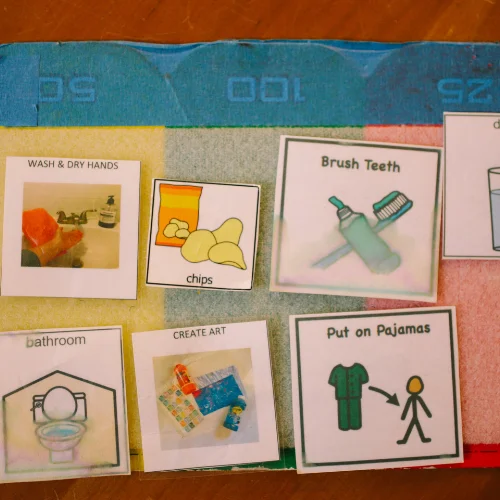The Alzheimer’s Vacant Look: How to Deal With It?
Have you ever locked eyes with someone only to find their gaze distant and unresponsive? It’s as if they are present physically, yet their soul seems miles away. This phenomenon is commonly known as the “Alzheimer’s vacant look” – a puzzling aspect of Alzheimer’s disease that leaves both patients and their loved ones searching for answers. Let’s take a closer look at this issue— that seems to be bothering family members and friends of those living with Dementia.
Demystifying Alzheimer’s Disease

Before we delve into the vacant look, it’s essential to grasp the foundation of Alzheimer’s disease. It is a progressive neurodegenerative disorder that primarily affects the brain’s cognitive functions, including memory, thinking, and behavior. Alzheimer’s is prevalent among the elderly population, and as our society ages, it becomes increasingly crucial to comprehend its impact.
The Vacant Look – A Window into the Mind

One of the most perplexing aspects of Alzheimer’s is the vacant look that many patients display. It’s as if a fog has descended upon their consciousness, leaving them disoriented and detached from the present moment. While it may seem disheartening to witness a loved one with this distant gaze, it is essential to remember that this is merely a manifestation of the disease and not a reflection of their true self.
For instance, consider a scenario where you visit your aging parent, and upon entering the room, they glance at you with vacant eyes. You might be tempted to feel hurt or rejected, but understanding the nature of Alzheimer’s helps us approach the situation with empathy and compassion.
Unraveling the Causes
The vacant look in Alzheimer’s patients can be attributed to various factors. Firstly, the accumulation of amyloid plaques and tau tangles in the brain disrupts communication between neurons, leading to cognitive impairment. As the disease progresses, brain regions responsible for memory and emotions become affected, causing the disconnect between the individual and their surroundings.
Additionally, neurotransmitter imbalances further contribute to the vacant look. Dopamine, which plays a crucial role in regulating mood and attention, is often depleted in Alzheimer’s patients, intensifying their emotional disconnection.
The Art of Connection
While the vacant look might seem insurmountable, finding ways to connect with Alzheimer’s patients is essential for their emotional well-being and overall quality of life. Despite their cognitive decline, they can still experience emotions and feelings, making it vital to engage them in meaningful ways.
For instance, consider reminiscing about shared memories or engaging in activities that stimulate their senses, such as listening to their favorite music or looking at old photo albums. Simple gestures like holding their hand or offering a warm smile can also help establish a connection beyond words.
Communicating with Compassion

When interacting with someone exhibiting a vacant look, it’s essential to approach them with patience and understanding. Avoid talking down to them or becoming frustrated when they don’t respond as expected. Instead, adopt a gentle tone and use simple, clear language to make communication easier.
Imagine you’re visiting your grandparent who has Alzheimer’s, and they seem lost in their thoughts. Instead of bombarding them with rapid questions, try calmly asking about their day or sharing a story that might trigger memories. By doing so, you allow them the time and space they need to process and respond.
Cherishing Moments of Clarity
While the vacant look is prevalent in Alzheimer’s patients, there are moments of clarity that shine through the fog of forgetfulness. These instances can be heartwarming and create cherished memories for both the individual and their loved ones.
For instance, imagine spending time with your elderly relative during a family gathering. As you engage in activities and conversation, there might be brief moments when their eyes light up with recognition or when they share a meaningful story from their past. Embrace these moments, as they are a testament to the enduring spirit within despite the challenges posed by Alzheimer’s.
Embracing the Journey Together

Navigating the journey of Alzheimer’s with a loved one is undoubtedly challenging, but it is essential to remember that you are not alone. Reach out to support groups and resources available in your community or online, where you can connect with others who share similar experiences.
Remember, caregiving for a person with Alzheimer’s requires immense strength and patience. Self-care is crucial during this time, as it allows you to be a better caregiver and support system for your loved one.
Why do Alzheimer’s patients display a vacant gaze?
Alzheimer’s patients often display a vacant gaze due to the progressive deterioration of brain function caused by the disease. As the condition advances, neural connections in the brain become disrupted, leading to a decline in cognitive abilities and memory loss.
Consequently, the affected individuals may struggle to recognize familiar faces or places, resulting in a distant and unfocused stare. Imagine trying to recall a cherished memory from your childhood, only to find the details slipping away, leaving you feeling perplexed and disconnected from the present moment.
This is similar to the experience of someone with Alzheimer’s, as they grapple with their fading sense of self and struggle to make sense of their surroundings.
The vacant gaze can also be attributed to the buildup of abnormal proteins, such as amyloid plaques and tau tangles, in the brain. These protein aggregates disrupt communication between nerve cells, causing the characteristic cognitive decline associated with Alzheimer’s. Think of these proteins as tangled roadblocks that obstruct the smooth flow of information between different regions of the brain, leading to confusion and a distant expression.
Furthermore, the loss of cognitive function in Alzheimer’s patients affects their ability to engage in conversations or maintain eye contact. As a result, they may appear disinterested or detached during interactions, further contributing to the vacant gaze.
It’s like trying to participate in a discussion when your thoughts are jumbled and your words fail to express what you truly mean. This difficulty in communication often leads to frustration and social withdrawal, compounding the perception of a vacant expression.
Another contributing factor to the vacant gaze is the emotional impact of the disease on patients and their loved ones. Alzheimer’s takes a toll on the individual’s sense of identity and independence, leading to feelings of helplessness and isolation.
Consequently, the emotional burden can reflect in their facial expressions, presenting as a distant and vacant look. Just as anyone facing immense challenges might have moments of introspection or detachment, Alzheimer’s patients often display this vacant gaze as they confront the internal struggle caused by the disease.
How can caregivers connect with individuals exhibiting the vacant look?
Connecting with individuals exhibiting a vacant look can be challenging, but there are several approaches caregivers can take to establish meaningful connections. First and foremost, it’s crucial to approach the person with empathy and understanding. Simply sitting beside them and offering a gentle smile can create a comfortable atmosphere.
For instance, if you’re caring for an elderly person with dementia, softly holding their hand and maintaining eye contact can convey warmth and reassurance.
Next, engaging in non-verbal communication can be highly effective. Using gestures, such as nodding and mirroring their expressions, shows that you are present and attuned to their emotions.
For example, if the individual smiles, try mirroring that smile to foster a sense of familiarity and trust. Additionally, using touch appropriately can convey compassion and care. A gentle pat on the back or a warm hug, if appropriate and welcomed, can demonstrate emotional support.
Finding common interests and reminiscing about shared experiences can also help bridge the gap. For example, if the person once enjoyed gardening, show them a picture of a garden and ask if they ever had one. Sharing stories about your own experiences can encourage them to open up as well. Remember to be patient and give them time to respond; silence doesn’t necessarily mean disinterest.
Moreover, incorporating familiar objects or activities into their daily routine can evoke memories and emotions. For instance, if they used to enjoy listening to music, play their favorite tunes and observe their reactions. Sometimes, certain sensory stimuli like the smell of a favorite food or the feel of a soft blanket can awaken nostalgic feelings and prompt engagement.
Is there a specific treatment to address the vacant look in Alzheimer’s patients?
When it comes to addressing the vacant look in Alzheimer’s patients, it’s essential to understand that this symptom is a manifestation of the cognitive decline and memory loss associated with the disease.
While there isn’t a specific treatment solely targeting the vacant look itself, various approaches can improve the overall well-being and quality of life of individuals with Alzheimer’s.

Firstly, engaging patients in meaningful activities can help reduce the frequency of vacant looks. These activities could be as simple as listening to familiar music, doing puzzles, or participating in reminiscence therapy. By stimulating their cognitive and emotional connections, it can create moments of clarity and engagement, reducing the vacant stare.
Secondly, maintaining a structured routine and a familiar environment can be beneficial. Alzheimer’s patients often find comfort in familiarity, and having a consistent daily schedule can help reduce confusion and disorientation, leading to fewer vacant expressions.
Additionally, caregivers and family members play a crucial role in supporting Alzheimer’s patients. Providing emotional support and being patient and understanding during moments of vacant looks can help ease any potential distress. Simple gestures, like offering a comforting touch or maintaining eye contact, can create a sense of connection and reassurance.
Conclusion: Bridging the Gap
Alzheimer’s vacant look is a poignant reminder of the profound impact of this disease on individuals and their families. Understanding the causes behind this distant gaze and approaching it with compassion is key to creating moments of connection and maintaining the emotional well-being of those affected.
If you’ve had experiences with Alzheimer’s, whether as a caregiver or a family member, I’d love to hear your insights. How have you found ways to connect with your loved ones during their moments of vacant gaze?
Please share your thoughts in the comments section below, as your experiences might inspire and support others on this journey.
Let’s come together to build a community of understanding and compassion for those living with Alzheimer’s and their caregivers.
